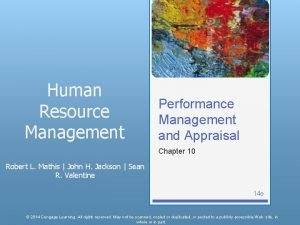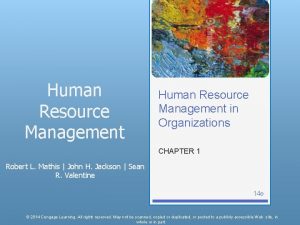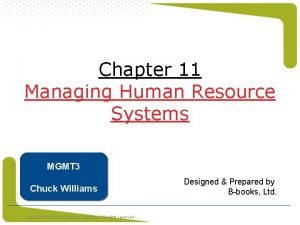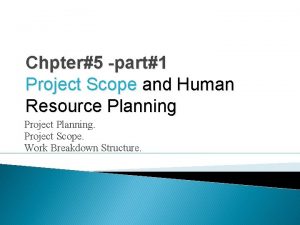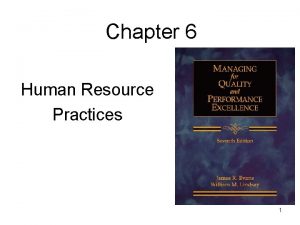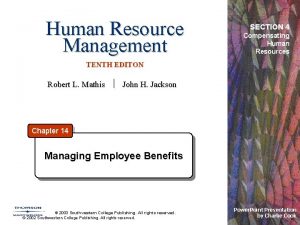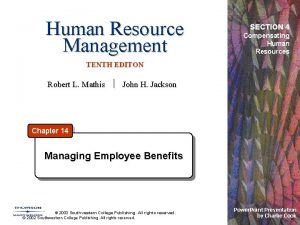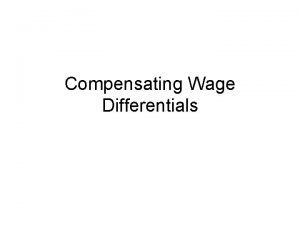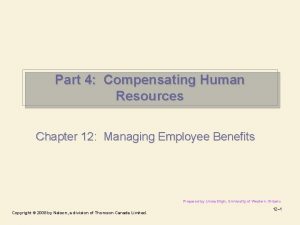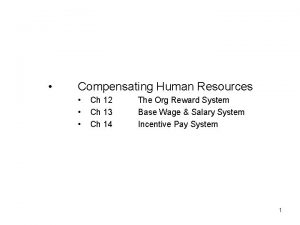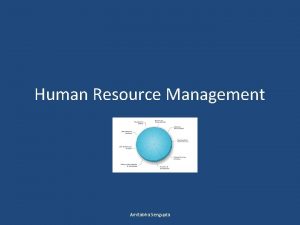Human Resource Management SECTION 4 Compensating Human Resources










































- Slides: 42

Human Resource Management SECTION 4 Compensating Human Resources TENTH EDITON Robert L. Mathis John H. Jackson Chapter 12 Compensation Strategies and Practices © 2003 Southwestern College Publishing. All rights reserved. © 2002 Southwestern College Publishing. All rights reserved. Power. Point Presentation by Charlie Cook

Learning Objectives After you have read this chapter, you should be able to: – Identify two general types of compensation and the components of each. – Give examples of two different compensation philosophies in organizations. – Discuss four strategic compensation design issues. – Describe three considerations affecting perceptions of pay fairness. – Identify the basic provisions of the Fair Labor Standards Act (FLSA). © 2002 Southwestern College Publishing. All rights reserved. 2

Learning Objectives (cont’d) – Define job evaluation and discuss four methods for of performing it. – Outline the process of building a wage and salary administration system. – Discuss how to establish a pay-for-performance system. © 2002 Southwestern College Publishing. All rights reserved. 3

Compensation Systems § Objectives of an Effective Compensation System: – Legal compliance with all appropriate laws and regulations – Cost effectiveness for the organization – Internal, external, and individual equity for employees – Performance enhancement for the organization © 2002 Southwestern College Publishing. All rights reserved. 4

Nature of Compensation § Types of Rewards – Intrinsic • Intangible, psychological and social effects of compensation – Extrinsic • Tangible, monetary and nonmonetary effects of compensation © 2002 Southwestern College Publishing. All rights reserved. 5

Components of A Compensation Program Figure 12– 1 © 2002 Southwestern College Publishing. All rights reserved. 6

Direct Compensation © 2002 Southwestern College Publishing. All rights reserved. 7

Typical Division of HR Responsibilities: Compensation Figure 12– 2 © 2002 Southwestern College Publishing. All rights reserved. 8

Continuum of Compensation Philosophies Figure 12– 3 © 2002 Southwestern College Publishing. All rights reserved. 9

Compensation Approaches Figure 12– 4 © 2002 Southwestern College Publishing. All rights reserved. 10

Compensation Quartile Strategies Figure 12– 5 © 2002 Southwestern College Publishing. All rights reserved. 11

Decisions About Compensation Levels © 2002 Southwestern College Publishing. All rights reserved. 12

Competency-Based Pay Limitations (How many? ) Pricing Competencies Competency. Based Pay Systems KBP/SBP Maintenance of Competencies © 2002 Southwestern College Publishing. All rights reserved. Training 13

Competency-Based Systems Outcomes Figure 12– 6 © 2002 Southwestern College Publishing. All rights reserved. 14

Individual vs. Team Rewards Using Team-Based Reward Systems Use skill-based pay for the base. Make system simple and understandable. Use variable pay based on business entity performance Distribute variable rewards at the team level Maintain a high degree of employee involvement © 2002 Southwestern College Publishing. All rights reserved. 15

Perceptions of Pay Fairness © 2002 Southwestern College Publishing. All rights reserved. 16

Equity Considerations in Compensation Figure 12– 7 © 2002 Southwestern College Publishing. All rights reserved. 17

Fair Labor Standards Act (FSLA) of 1938 Provisions of the Act Minimum wage requirement sets wage floor Child labor (under 14 years old) is prohibited Requires overtime payments for non-exempt employees Exempts highly-paid computer workers Requires overtime (1½) pay for hours over 40 hours Requires compensatory time at overtime (1½) pay rates © 2002 Southwestern College Publishing. All rights reserved. 18

Wage/Hour Status Under Fair Labor Standards Act Figure 12– 8 a © 2002 Southwestern College Publishing. All rights reserved. 19

Wage/Hour Status Under Fair Labor Standards Act Figure 12– 8 b © 2002 Southwestern College Publishing. All rights reserved. 20

Wage/Hour Status Under Fair Labor Standards Act Figure 12– 8 c © 2002 Southwestern College Publishing. All rights reserved. 21

The IRS Test for Employees and Independent Contractors Source: U. S. Internal Revenue Service. © 2002 Southwestern College Publishing. All rights reserved. Figure 12– 9 22

Other Laws Affecting Compensation § Davis-Bacon Act of 1931 – Required payment of “prevailing wage” by firms engaged in federal construction projects. § Walsh-Healy Public Contracts Act and the Service Contracts Act – Extended the payment of “prevailing wage” to service contracts – Required overtime payment for any employee hours worked over eight hours in one day; applies only to to federal contracts, not the private sector. © 2002 Southwestern College Publishing. All rights reserved. 23

Pay and Gender § Equal Pay Act of 1963 – Requires that men and women be paid the same for performing substantially similar jobs with limited non-gender exceptions (e. g. , merit and seniority). § Issue of Pay Equity – Similarity in pay for all jobs requiring comparable level of knowledge, skills, and abilities, even if actual duties and market rates differ significantly. © 2002 Southwestern College Publishing. All rights reserved. 24

Compensation Administration Process Figure 12– 10 © 2002 Southwestern College Publishing. All rights reserved. 25

Job Evaluation § Job Evaluation – The systematic determination of the relative worth of jobs within an organization. § Benchmark Job – A job found in many organizations and performed by several individuals who have similar duties that are relatively stable and require similar KSAs. © 2002 Southwestern College Publishing. All rights reserved. 26

Job Evaluation Ranking Classification Job Evaluation Methods Factor Comparison © 2002 Southwestern College Publishing. All rights reserved. Point Method 27

Job Evaluation Point Chart Figure 12– 11 © 2002 Southwestern College Publishing. All rights reserved. 28

Legal Issues and Job Evaluation Americans with Disabilities Act Job evaluations may not identify job functions related to physical demands as essential Job Evaluation Gender Issues Traditional job evaluations place less weight on knowledge, skills, and working conditions for female-dominated jobs © 2002 Southwestern College Publishing. All rights reserved. 29

Developing Pay Surveys Select Employers with Comparable Jobs Determine Jobs to be Surveyed Decide What Information Is Needed Conduct Survey © 2002 Southwestern College Publishing. All rights reserved. 30

Pay Structures § Market Line – The line on a graph showing the relationship between the job value, as determined by job evaluation points, and pay survey rates. § Common Pay Structures – Hourly and salaried – Office, plant, technical, professional, managerial – Clerical, information technology, professional, supervisory, management, and executive © 2002 Southwestern College Publishing. All rights reserved. 31

Establishing Pay Structures Figure 12– 12 © 2002 Southwestern College Publishing. All rights reserved. 32

Pay Structures (cont’d) § Pay Grades – A grouping of individual jobs having approximately the same job worth. § Broadbanding – The practice of using fewer pay grades having broader pay ranges that in traditional systems. – Benefits • • • Encourages horizontal movement of employees Is consistent with trend towards flatter organizations Creates a more flexible organization Encourages competency development Emphasizes career development © 2002 Southwestern College Publishing. All rights reserved. 33

Traditional Pay Structure vs. Broadbanding Figure 12– 13 © 2002 Southwestern College Publishing. All rights reserved. 34

Pay Scattergram Figure 12– 14 © 2002 Southwestern College Publishing. All rights reserved. 35

Typical Pay Range Widths Figure 12– 15 © 2002 Southwestern College Publishing. All rights reserved. 36

Example of Pay Grades and Pay Ranges Figure 12– 16 © 2002 Southwestern College Publishing. All rights reserved. 37

Pay Rate Issues § Rates Out of Range – Red-Circled Employees • An incumbent (current jobholder) who is paid above the range set for the job. – Green-Circled Employees • An incumbent who is paid below the range set for the job. § Pay Compression – A situation in which pay differences among individuals with different levels of experience and performance in the organization becomes small. © 2002 Southwestern College Publishing. All rights reserved. 38

Issues Involving Pay Increases § Seniority – Time spent in an organization or on a particular job. – Used to determine eligibility for organizational rewards and benefits. § Maturity Curve – A curve that depicts the relationship between experience and pay rates. – Assumption is that as experience increases, proficiency and performance increase. © 2002 Southwestern College Publishing. All rights reserved. 39

Issues Involving Pay Increases § Cost-of-Living Adjustments (COLA) – A percentage increase in wages that allows employees to maintain the same real wages in a period of economic inflation. – Adjustments are tied to changes in an economic measure (e. g. , the Consumer Price Index). § Lump-Sum Increases (LSI) – A one-time payment of all or part of a yearly pay increase. – Lump-sum payments do not increase base wages © 2002 Southwestern College Publishing. All rights reserved. 40

Pay Adjustment Matrix Figure 12– 17 © 2002 Southwestern College Publishing. All rights reserved. 41

Compa-Ratio Example § Compa-ratio – The pay level divided by the midpoint of the pay range. © 2002 Southwestern College Publishing. All rights reserved. 42
 Time management in human resource management
Time management in human resource management Human resource management in retail management
Human resource management in retail management Function of personnel management
Function of personnel management Project human resource management pmbok ppt
Project human resource management pmbok ppt Human resource management pmbok
Human resource management pmbok Importance hrm
Importance hrm Human resource management in restaurants
Human resource management in restaurants Induction for a job definition
Induction for a job definition Chapter 2 human resource management
Chapter 2 human resource management Chapter 9 human resource management
Chapter 9 human resource management Hrms shanker group
Hrms shanker group Mbo performance appraisal method
Mbo performance appraisal method Current issues in human resource management
Current issues in human resource management Ba human resource management
Ba human resource management Higher business technology in human resources
Higher business technology in human resources Human resource management gaining a competitive advantage
Human resource management gaining a competitive advantage Downsizing
Downsizing Human resource management gaining a competitive advantage
Human resource management gaining a competitive advantage Hrm question paper 2020
Hrm question paper 2020 Management fifteenth edition
Management fifteenth edition Human resource management 15th edition
Human resource management 15th edition Gary dessler human resource management
Gary dessler human resource management Human resource management strategy and analysis
Human resource management strategy and analysis Utilitarian organization
Utilitarian organization Chapter 11 human resource management
Chapter 11 human resource management Human resource management chapter 1
Human resource management chapter 1 Human resource management chapter 1
Human resource management chapter 1 Applied psychology in human resource management
Applied psychology in human resource management Nature of hrm
Nature of hrm Unit 3 human resource management
Unit 3 human resource management Separation in human resource management
Separation in human resource management Human resources and job design
Human resources and job design Human resources management definition
Human resources management definition Human resource management weiterbildung
Human resource management weiterbildung Human resource management syllabus harvard
Human resource management syllabus harvard Hrm course syllabus
Hrm course syllabus Hrmis system
Hrmis system Defintion of hrm
Defintion of hrm Human resource management definition
Human resource management definition Human resource management laura portolese
Human resource management laura portolese Wbs human resource management
Wbs human resource management Toyota hrm practices
Toyota hrm practices International human resource management dowling 6th edition
International human resource management dowling 6th edition











